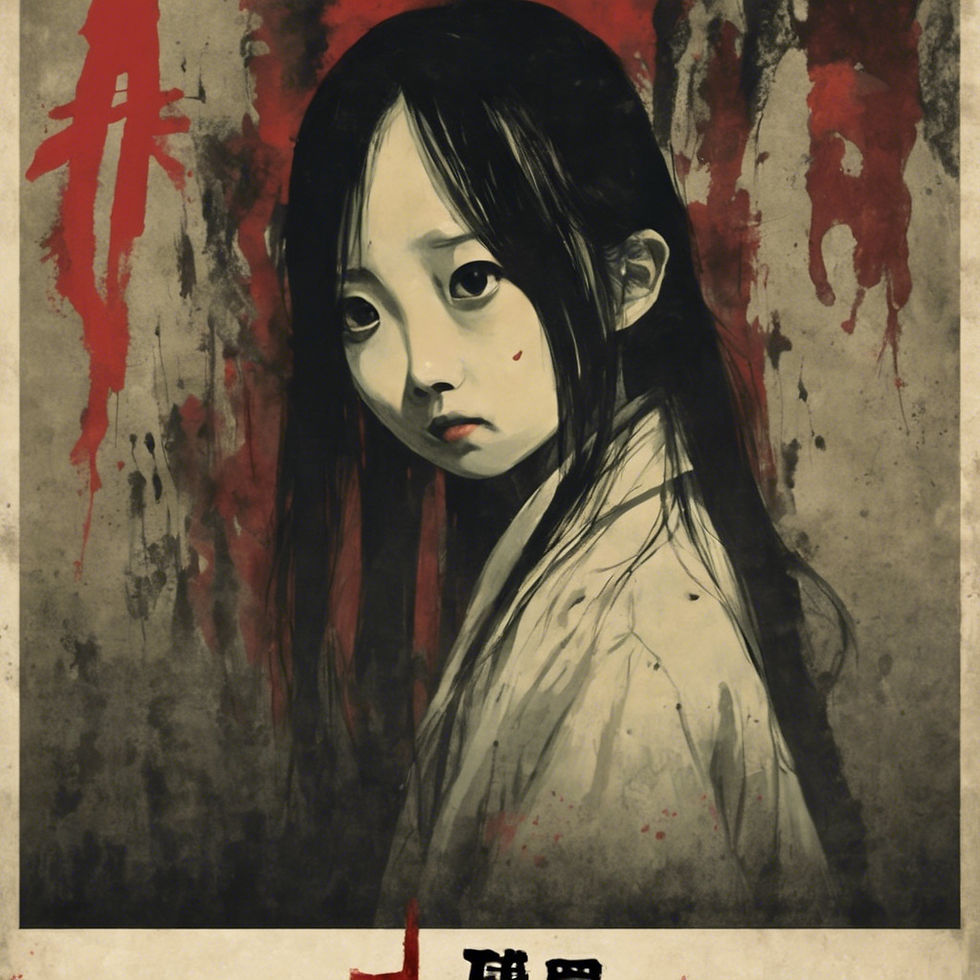‘ONRYOU’ IN ‘J – HORROR’ : A PORTAL TO THE POST WORLD-WAR SOCIOCULTURAL CONDITION OF WOMEN IN JAPAN. Part 4: Dark Water by Hideo Nakata
- Sharmistha Chakrabartty

- Apr 24, 2024
- 3 min read
This is the fourth part of the six-part blog post about "Onryou in J-Horror". In this part we will discuss about the 2002 film, Dark water by Hideo Nakata. This film also has a Hollywood remake of same name, released in 2005. However, we are not considering that film in this discussion.
Here, the protagonist, Matsubura Yoshimi, is in middle of her
divorce and custody battle over Ikuko, her six year old daughter. Here the age of the child is important because in Japanese folklore, children below the age of 7 are considered a part of mother (still a fetus) and does not have a separate identity. When she and her daughter moves into a new apartment, she
encounters the spirit of Mitsuko, a six year old who was abandoned by her mother and died after falling inside the water tank of the apartment. Yoshimi was herself a victim of parental negligence, finally abandons her own daughter to become Mitsuko’s surrogate mother. In Nightmare Japan, Jay McRoy writes, " (Yoshimi's action) represents one potential, if ultimately limited, approach to breaking the cycle of individual and cultural anxiety accompanying both the increasing emergence of single parent families in late capitalist Japan, as
well as the transforming roles of women in the home and workplace.”
Relationship of mother and daughter, obligation of one to the other and abandonment and isolation faced in nuclear families forms the premise of Dark Water. Here, the vengeful spirit is not of ‘wronged women’ rather it is of ‘Vengeful Foetus’, Mitsuko (six year old) had been abandoned by her mother and lived a life of loneliness. She seeks her mother after death and in Yoshimi she tries to find
it. Yoshimi choses Mitsuko, in order to appease her vengeful spirit and protect her own daughter from being harmed. By sacrificing herself and her current familial duty, Yoshimi fulfills her duty towards the greater community and thus becomes the “archetypical self-sacrificing woman”
The very first scene of Dark water shows Yoshimi, as a child, waiting inside the school for her mother to come. This shot emphasis Yoshimi’s isolation. Nakata through the first scene successfully establishes the ‘theme of abandonment’ which will later justify Yoshimi’s action of accepting Mitsuko as her daughter and help us to empathize with Mitsuko’s character. The colour palette that uses blue
and grey (along with yellow and brown for past scenarios) further enhances the theme. The colors here represent the inner turmoil of Yoshimi. Here the ‘red bag’ becomes symbolic of the uncanny, the vengeful foetus and the looming death. This film has many elements with symbolic meaning. The water tank represents the womb of the archaic mother in which Mitsuko fell, years ago. In the beginning of the climax, when Yoshimi goes up to the water tank, we can hear banging from inside the tank followed by bulging of it. This scene without a doubt, establishes Mitsuko as the ‘vengeful foetus’ which is trapped inside the womb. Water gushing out is symbolic of birth and after this ‘birth’
Mitsuko replaces Ikuko (in the bathroom scene).
In Japanese culture water symbolizes isolation, alienation, pollution, corruption, a middle ground between life and death (This symbolic representation of water has been used in Nakata’s Ringu, about which we will discuss later.) In Dark water, water also symbolizes the inner turmoil and mental disturbance of Yoshimi (Scenes of rain pouring and water gushing out of everywhere) and finally becomes the harbinger of death.
In Dark Water, there was a cycle of abandonment and every generation suffered from it. It represented not only the economic turmoil, changing gender roles (we see a single mother, earning for the household), breaking of Japanese extended family and the effects of multi-generational divorce but also how it modifies the Japanese family structure (the core of ‘ie system’ and the smallest unit of a nation) and creates a cyclic pattern of alienation which has the potential of becoming catastrophic for the future generation.
In the next post we will talk about, the film Ringu by Hideo Nakata.
To be continued...
Let's give credit where it is due. The books I referred to :
Cherry, Brigid. ‘Horror’, Routledge Taylor and Francis Group, New York, (2009)
‘Horror to the extreme’, Hong Kong University Press, Hong Kong, (2009).
McRoy, Jay, ‘Nightmare Japan’, Rodopi, New York, (2008).
Balmain, Colette, ‘Introduction to Japanese Horror films’. Edinburgh University Press, Great Britain, (2008)



Comments